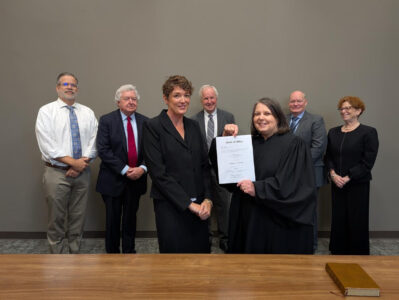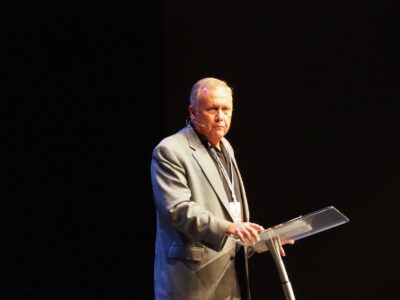KU budget cuts proceeding as planned; $300M donation to athletics department won’t relieve pressure elsewhere
University plans to begin target pay increases in January

photo by: Shawn Valverde/Special to the Journal-World
The University of Kansas campus is pictured in this September 2023 aerial photo.
A recent record-breaking $300 million gift to KU’s athletic department won’t help stave off millions in budget cuts to the university’s general operations next month, the university’s chief financial officer said Wednesday.
When KU in June began announcing the need for budget cuts, one of the factors cited was the fundamental shift in college athletics that now allows universities to begin sharing revenue with students athletes. At the time, Jeff DeWitt, KU’s CFO, estimated the financial challenges in the athletic department would require KU to forgive about $10 million in payments the general university receives from the athletic department for tuition, housing and food services, among other items.
In August, though, Kansas Athletics announced a $300 million gift from longtime donor David Booth, with $75 million dedicated to the second phase of KU’s football stadium renovations and the rest to be used as needed by the athletics department.
On Wednesday, DeWitt said the donation had not changed KU’s plans to forgive the $10 million in athletic department payments during these current budget deliberations, but the university will evaluate the athletic department’s finances yearly to determine whether the payments could resume at past levels. The new financial model in college athletics, though, will make it challenging, he predicted.
“I don’t see any university in the country where athletics is going to be able to carry itself in the longterm,” DeWitt said. “This is a thing we are going to have to evaluate every year.”
General university support of athletics departments is becoming more common, in large part, because of changes that now allow athletics departments to share up to $20.5 million per year in revenue with student athletes. Schools aren’t required to share the revenue, but those that don’t are expected to face difficulty in recruiting the top student athletes.
Booth’s donation is expected to help KU make those revenue sharing payments for years to come, but DeWitt said Booth’s donation doesn’t arrive all at once. Rather, it will come in phases, and much of the initial donations will be dedicated to the phase II renovations of the football stadium, which was the wish of Booth.
DeWitt also highlighted that the amount of revenue sharing payments KU Athletics will make in future years is expected to rise. The current $20.5M cap — which was set as part of a national lawsuit settlement — is estimated to grow to about $33 million by 2035.
Departments across KU’s Lawrence campus are reviewing potential budget cuts, with proposals due to DeWitt’s office by mid-October. KU expects to book $16 million in budget cuts by June 30, which is the end of KU’s fiscal year. Then, between July 1 to June 30, 2027, KU expects to accomplish $32 million in annual budget savings.
DeWitt is telling university members that the cuts will be worth it. He said the No. 1 reason the cuts are needed is because KU must free up money to fund pay increases for university employees who currently make below what their counterparts in the private sector or other research universities earn.
DeWitt said KU plans in January to begin making targeted wage increases for employees who are below the “market rate” for their professions. KU has paid for a market study that looks at wages in the private sector in the region and also at wages for similar research universities. Some KU positions have wages that fall completely below the range listed in the survey. Those employees would be the first to receive a market wage adjustment, with the goal of at least getting those employees to the bottom of the listed pay range, DeWitt said.
Not all KU employees, however, should expect a pay increase. When KU in August announced its most recent budget cut goals, it warned employees that a 2.5% across-the-board pay increase for university employees may not happen. DeWitt on Wednesday said that is still expected to be the case.
DeWitt said KU does plan to return to more broad-based pay increases in the future, but for the current budget year is focusing only on making targeted wage increases. In future years, DeWitt said KU’s hope is to offer a mix of broad-based pay increases and also targeted wage increases for those employees who are below market pay rates.
Those targeted wage increases are expected to continue through fiscal year 2029, at which point KU hopes all employees will be earning wages similar to their counterparts in the private sector or at other major research universities.
KU, as the Journal-World reported last year, boosted the wages of 190 employees to ensure that all KU employees made a living wage of at least $17.42 per hour. Those pay increases largely impacted KU staff members, such as landscapers, custodians and other support staff.
DeWitt said the targeted wage increases in January are designed to impact faculty members as well. However, any changes to faculty pay will have to receive approval from a new union that represents KU faculty members. The university and the union are in the process of negotiating an initial contract, but the two parties can both agree to wage changes in the interim while that overall contract is being negotiated.
DeWitt said there was no timeline for when an overall contract between KU and the union is expected to be completed, but said the parties are meeting weekly.
Last month’s budget cut announcement also included a hiring freeze on the Lawrence campus. DeWitt, however, said the hiring freeze will be lifted on departments once they submit a budget in October.
DeWitt said the hiring freeze’s main purpose is to ensure that university departments did not fill vacant positions before fully considering their new budgets.
“It is not a hiring freeze in a traditional sense,” DeWitt said. “We want you to think it through and submit (the budget) before you decide to fill the position. Be strategic.”






